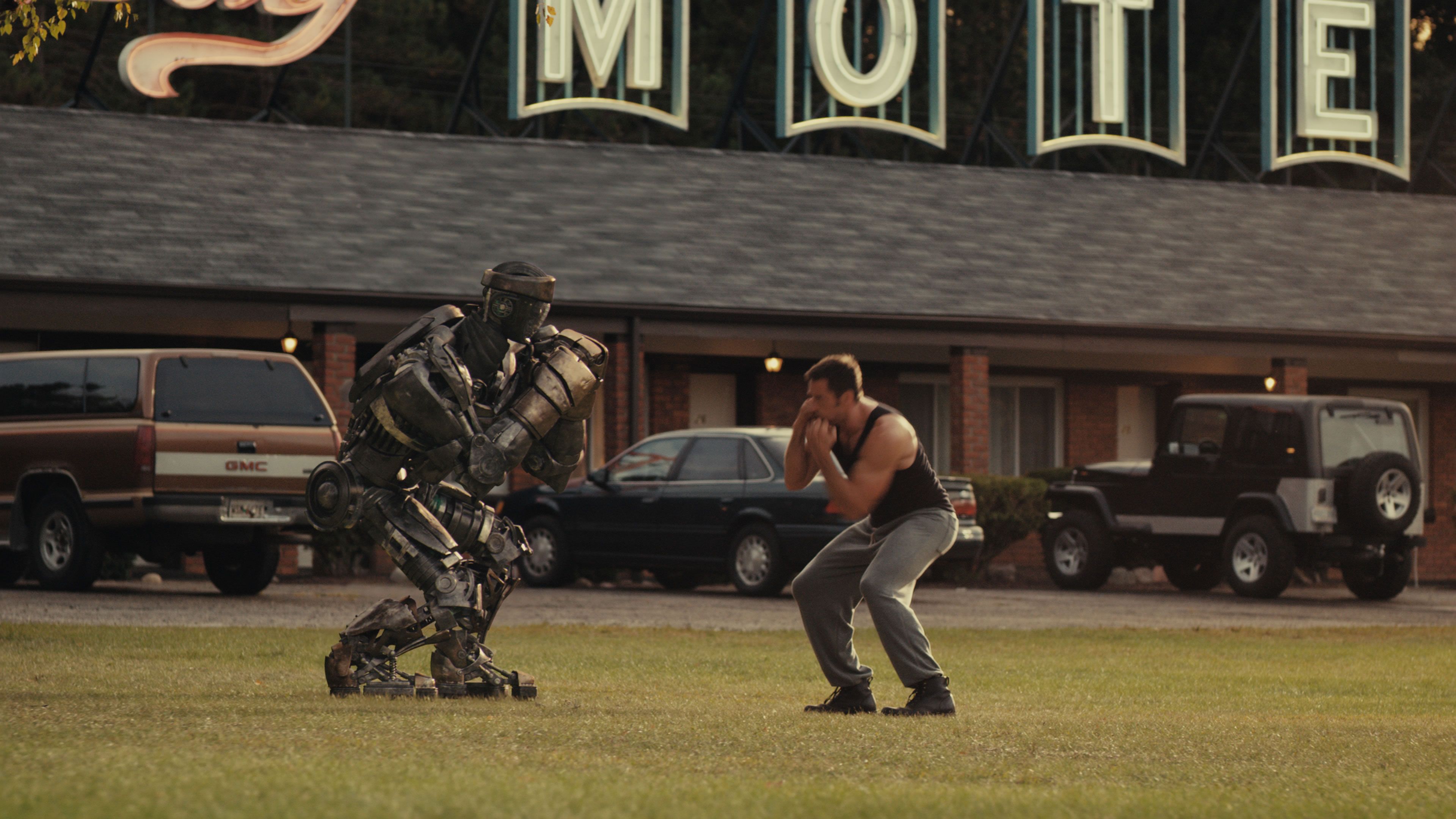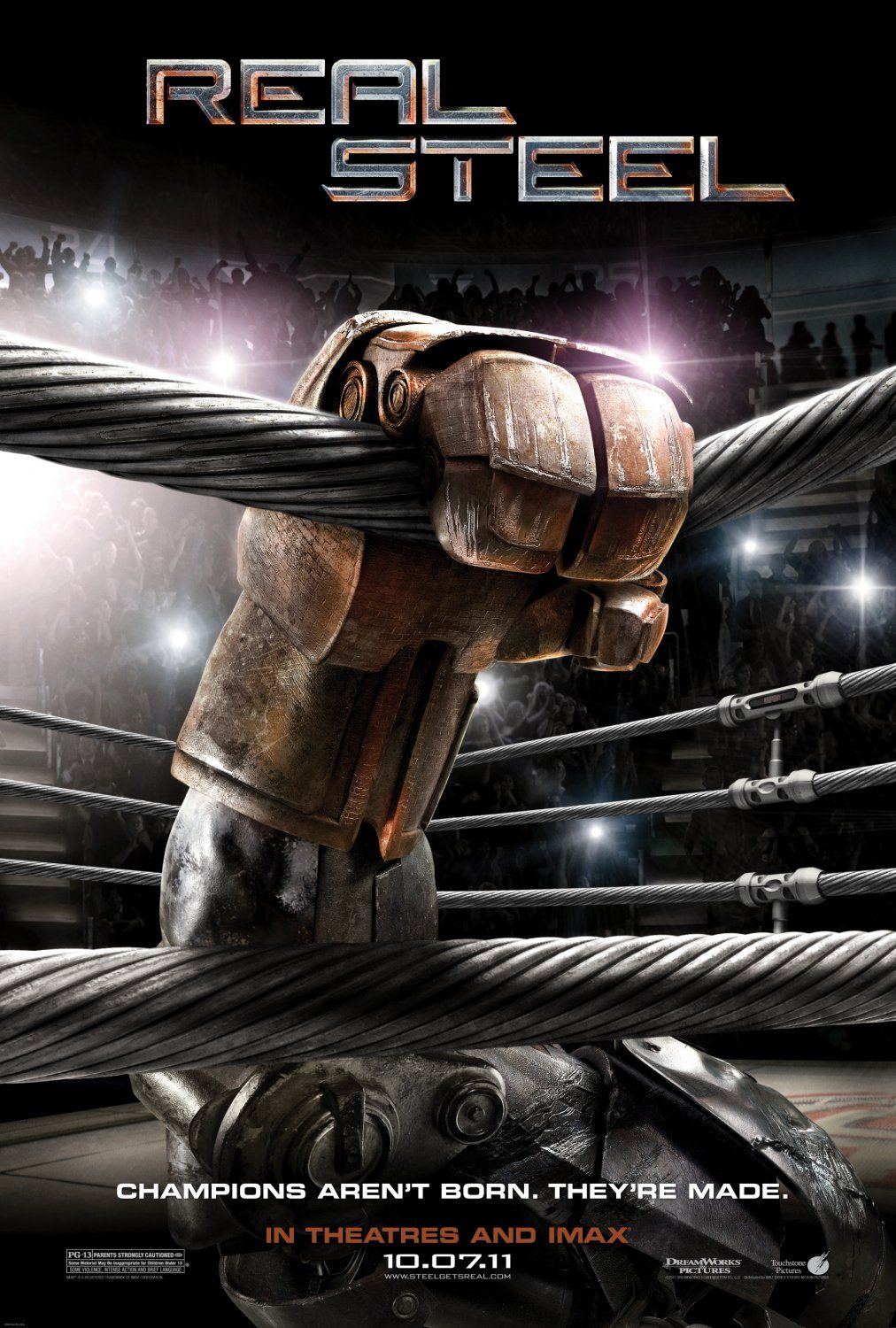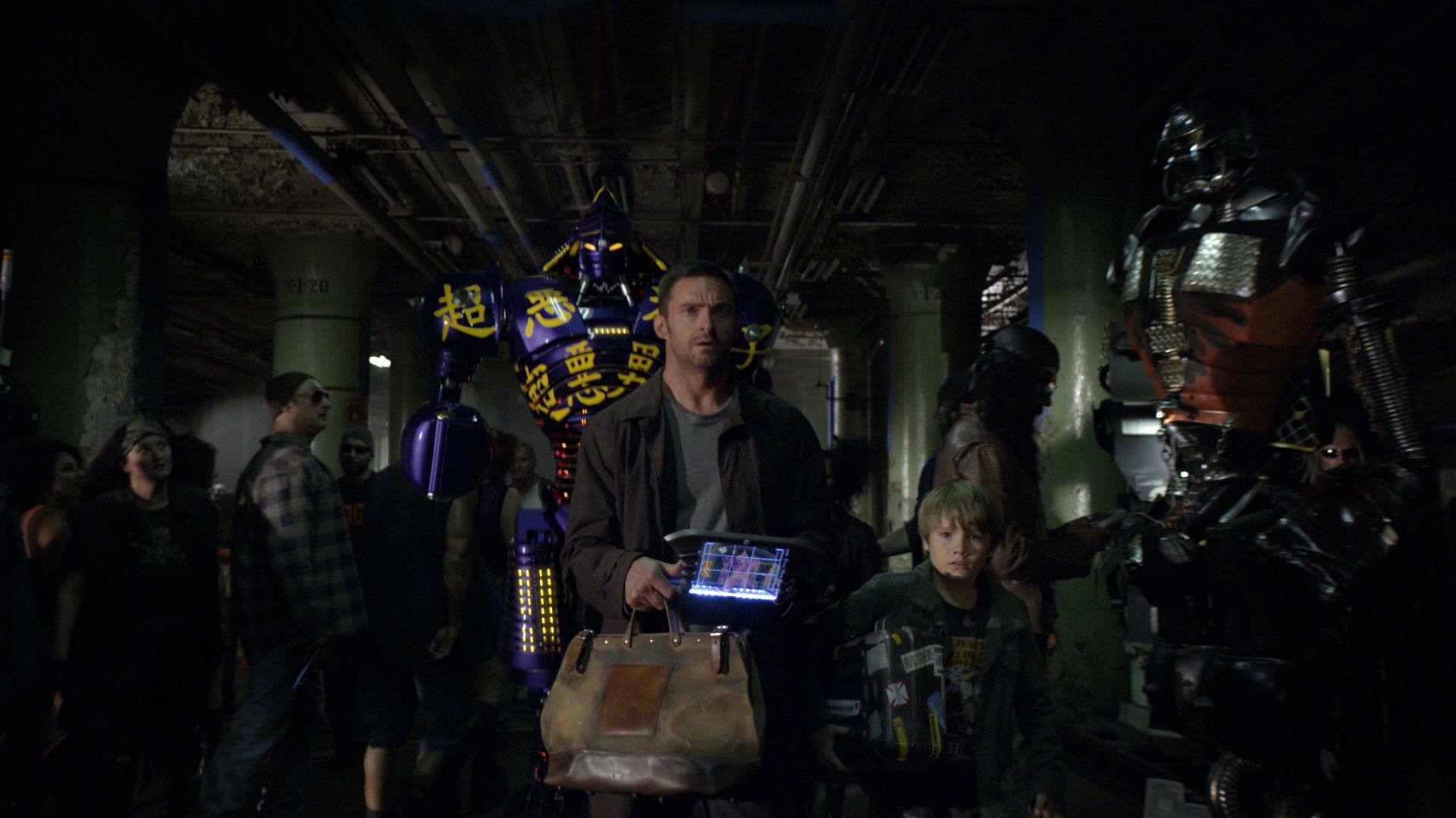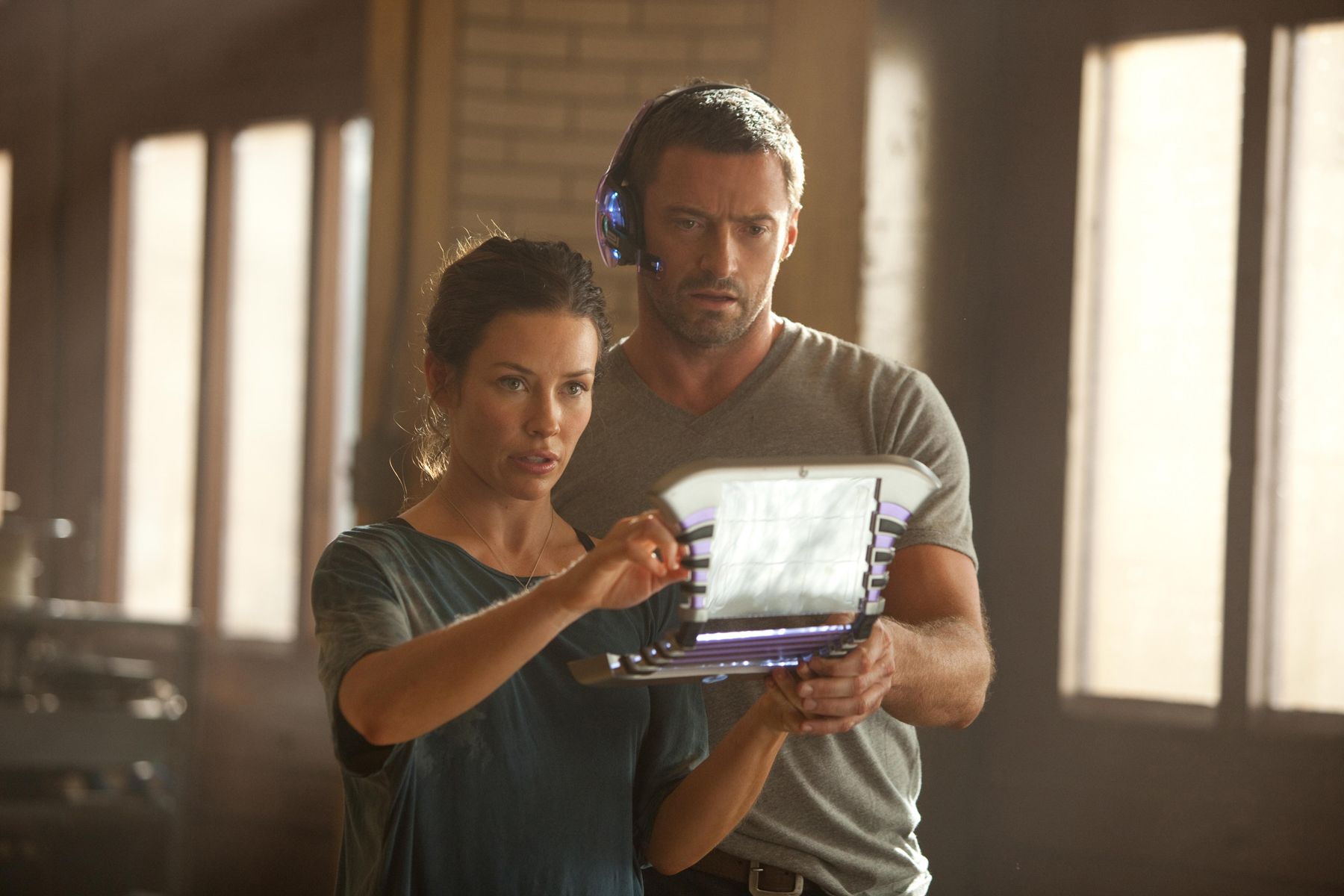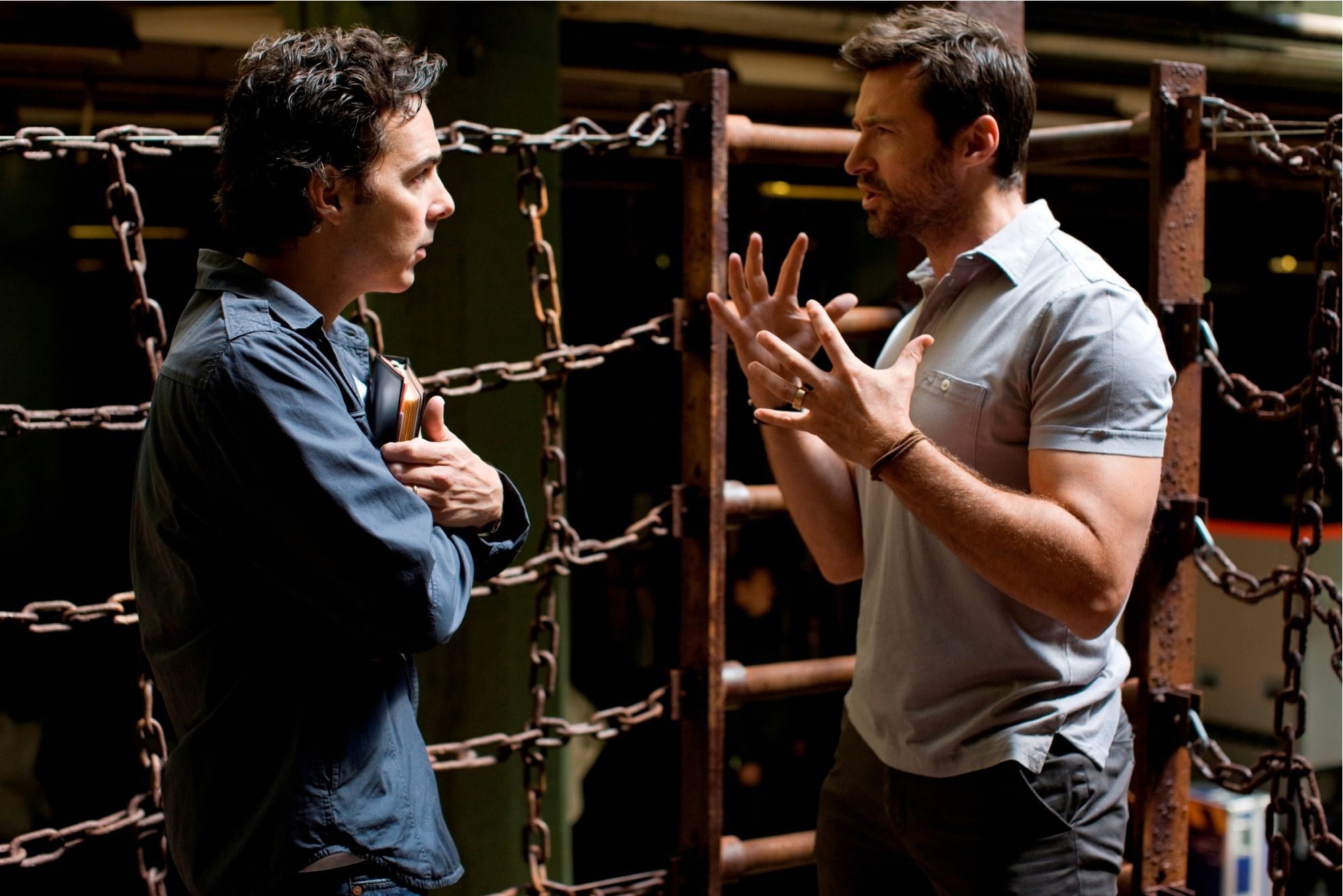Can you talk about the level of physicality for yourself in this movie?
Hugh Jackman: It's not as physical as a lot of other movies I've done, to be honest. There are some scenes, though, where you see me as a boxer, and you can see that I can box, so I had to make that look real. I prepared for quite awhile with Sugar Ray Leonard, which was pretty cool. I trained with him and another boxer, Michael Olajide Jr., for probably six months, in preparation for this. They helped me look like a boxer.
So do you actually move with the robot as he fights?
Hugh Jackman: Yes. You see in the beginning, with some of my robots, an advanced remote control. I also wear a headset and give voice commands, which is what I do most of the time. Then this robot (Atom) has a shadow function, which I used to load punch sequences in. You see me boxing and he's literally mimicking me.
Would you do that actually at the fight though, throwing punches at ringside, or is it all loaded in?
Hugh Jackman: I don't know how to answer that... yes, you do see me do that.
Was the WRB formed solely because of the entertainment value, or is it to protect people from getting brain damage, things like that?
Hugh Jackman: Well, in the Matheson short story, boxing was banned because a number of people were being killed. That was written in 1956, when boxing was kind of at its height. What Shawn smartly did, I think, is not base it on that, but more that it has just evolved. There is still boxing, but there's just no money in it anymore. If you went around the world and asked a bunch of people under 20 years old, to name a boxer, I bet they couldn't name one. They'd be able to name a UFC fighter though. When I was younger there was Mike Tyson and we watched everything. I'm not saying its gone, or its going to go, and it could easily be ignited by another fighter, but it's just that idea that UFC is more violent, that desire for more spectacle, has captured people's attention. That's the idea of the story. It's a fable, I'm not saying that's what it is going to be like.
Is the world that we're working in what drew you into this project, or was it the relationships?
Hugh Jackman: No, it was the relationships. By the way, the film is set 10 years from now and there are some cool, subtle little ideas here and there, but it's still very much the world we live in today. I said to Shawn we have to always remember to put in ping pong or javelin throwing or whatever. The sport, in a way, should be irrelevant, as far as the story is concerned. This story should work as a story. It is a sports story, but the type of sport or spectacle or effects, we cannot rely on that. You should be able to put in greyhounds in there and it should still work. The spectacle is a bit of a bonus, but the story is a bit like Rocky. There is a lot less boxing in that than you would imagine. It's not wall-to-wall boxing. There are a few key fights, but, really, it's this relationship.
Hugh Jackman: Well, Paper Moon was a big one for this. The thing about Charlie, and what I enjoy about Charlie, is he is desperate, he is down and out, but he's also quite a charming character in his way. He's an all or nothing kind of guy, so even when he is desperate and down and out, he's always pushing forward, until he's knocked down on the mat, he'll keep going. He's got debts here and there, and he's conning this person and that person, so it's been a lot of fun for me to play that. Obviously with Logan in Wolverine, he's very stoic and very macho, and says very little. Charlie isn't like that. He's more of a huckster.
How is it working with a child actor?
Hugh Jackman: It's funny because I have a 10-year-old. He's sitting right over there, actually. So, there's an obvious connection for me, but Dakota (Goyo) is a special boy, on screen and off screen. He's a very talented actor and I can ad-lib with him, and he'll just give it right back. He floors the crew constantly. He's very good, very alive, and he's like an old soul. I will predict he's going to be a huge movie star. Hopefully this will do very big things for him.
Charlie starts off rather unsympathetic, this deadbeat dad, but does he become more sympathetic?
Hugh Jackman: Really, his actions are pretty reprehensible in the movie. I'm in it, so it's hard to say, but you understand where he's coming from and you don't hate him. He's desperate, and everything does come from desperation. I think because he is this all-or-nothing kind of guy, and he's got a second chance, you're rooting for him, I hope.
Does your character have any mechanical expertise? It seems people are just building these massive robots in these home-grown operations.
Hugh Jackman: He's limited. He does what he has to do. There's no passion for him at all, in it. He knows what he knows, in terms of being able to buy a good robot, knowing what it's worth, how to operate it, obviously, but the brains, as far as the robotics go, is Bailey. She's sort of his partner, who is played by Evangeline Lilly. She understands and knows this stuff, and the kid kind of knows just as much as Charlie. Charlie's passion is boxing, so he has learned what he needs to know. He's not very successful at it, by the way. When you first meet him, he's not doing too great at it.
Do we see any flashbacks of you actually in the ring?
Hugh Jackman: We did shoot some, actually. Shawn and I came up with the idea, in the beginning, we decided I would be more out of shape. We shot some sequences, mainly for stills, that are in the movie, things like that. You don't see any video or any film flashback, but you do get a sense of it, about what he was like as a fighter.
It sounds like you have a lot of creative input in the movie. Is there anything specifically that you were able to bring to it?
Hugh Jackman: Well, Shawn and I got a script, which is quite different from this. It was a great concept and a great idea, but Shawn really took it to another level. Like he said before, he was working on it for seven months. At the beginning, he came to my room and, the way Shawn works is you just get up and start ad-libbing with him. We were in my living room and there are literally three or four scenes in this which came out of that.
It came out of your living room?
Hugh Jackman: Pretty much. I'm not saying they're all my ideas. Shawn is just a genius. Creatively, Shawn is very open. Even Dakota would have a few ideas about how to shoot things and he would say, 'OK, let's try it.'
What would you say is the overall tone of the movie? Is it more of a family film?
Hugh Jackman: I would genuinely say I would love to see this movie. I think you guys are all going to like it, I think my son is going to like it. When I first read the script, it reminded me of all those great Steven Spielberg movies. There's magic in that. It will have you jumping out of your seat. That's the way Shawn made it. He's very funny, he's very smart, and he wears his heart on his sleeve. He's just all heart. You see that in his movies. There's a confidence about him as a director. I wouldn't be surprised if it brings a tear to your eye and makes you jump out of your seat at the end.
With this SimulCam B, what's it like to actually see these robots on the set, as it's happening?
But you're still acting with guys in mo-cap suits and tennis balls.
Hugh Jackman: Yeah, but I know exactly what it is. I know exactly what I'm seeing. I totally see it all the time in movies, where you see an actor just make something up, and then a pterodactyl comes flying in that some kids drew. You can feel it. Often, in close ups, we get to use the real robot. It's pretty amazing. That makes a big difference. Just being able to see it makes a huge difference.
After Hugh Jackman was called back to the set, we watched a few minor shots being filmed. They packed specific sections of the arena with extras and, on cue, they would whip into a frenzy. The idea was to to shoot this same group of extras in different sections of the auditorium, which will be melded into one shot of a full auditorium. Movie magic, ladies and gentleman.
We also spoke with production designer Tom Meyer, who designed the robots and the world of Real Steel. Before Real Steel, Tom Meyer served as a production designer on Blue Crush, Orphan, and We Are Marshall. Here's what he had to say below.
Production Designer Tom Meyer:
Can you talk a bit about the design of Atom in particular?
Tom Meyer: There are such strong characters with strong personalities that, by the time you get to Atom, they want to be able to project themselves onto Atom. Really, Atom is that unfulfilled promise for Charlie. That's why I kind of have his face behind the mesh, so he became this kind of everyman, this Raggedy Andy, utilitarian doll. I wanted him to embody the nature of what he is, a sparring robot. He has the helmet and a mixture of raw strength, finesse, and teenage guile.
Can you talk about the kinds of things you did to the world, like futuristic items?
Tom Meyer: Oh, absolutely. I mean, there are still cars on the road from 50 years ago. I just passed one on the road coming down to meet you. We have a few new cars, concept cars, but we also have a lot of generic cars that, more or less, don't change. There are appliances, computers. HP is a partner of ours, and they help us develop certain new desktops and laptops. Nokia was a partner and we created a new cell phone with them. There are little touches with appliances changing and cars changing but, by and large, there is a lot of stuff that is very recognizable because it's all about the layering. It's important not to create a brown and grey post-apocalyptic world. This is a world like our world, 10 years in the future. It's about those little nuances, but, again, it was about trying to create classic Americana images so that you would forget about the time and not get so hung up.
Tom Meyer: Sure, this (Cobo Hall) is a perfect example. Michigan in general has a lot of great things. You have great urban centers, beautiful buildings, huge industry, and some industry which has been here from the beginning. We filmed in the original Model-T factory in Highland Park, which we re-purposed as an industrial opera house, which I think you saw some of. There are also beautiful rolling hillsides and countrysides and these classic small towns, with the courthouse in the center. You get that whole mesh of Americana, this cross-section of history and technology. Then you have places like Cobo Hall here, an old arena and, as you can see with the green screen, what we're doing is augmenting. We're just using the floor as a huge soundstage, and everything above will be replaced with digital.
Can you talk about your inspirations for the WRB?
Tom Meyer: Sure. We looked at boxing matches, and the physicality of boxing is about energy and energy displacement, at its core. It's two guys beating each other up, but when you think about what the ring is designed to do, you have a sprung floor that bounces with the boxers, you have ropes that absorb, it's all about energy absorption. So, I thought, if I have robots that are 1,200 or 1,500 pounds, I need a floor with seismic shocks underneath it, which is what you see underneath the floor. I got huge steel cables with lots of spring and lots of tension and all this cable coming off is just an extension of the corner post. It's kind of like a turnbuckle on steroids. It's to help see that energy, so they feel somewhat humanized. The ropes would shake, things that are understandable, but would make sense for a robot. That's why those cables are so thick. Every single nut and bolt was custom fabricated. 80% of our crew are from the industrial base of Detroit, the unions, steelworkers, carpenters. It's a manufacturing town.
Are there any limitations on the size of these robots?
Tom Meyer: Yeah, the height limitation is 8'6" and anywhere down from there. The idea is that there are three generations, and we're on our third generation of robot. Zeus is a G-3 and Atom is more of a G-2. They started with Generation 1, the first part of humanoid robots. There is a scene that kind of talks about it, but as far as the power source goes, it's a little undefined. They all have hand controllers, like a video game, and the idea is the same as when you play a game. You have a green bar and when it goes down to red, you get into trouble. It's based on energy use, you use more, your energy goes down faster.
Is it kind of like NASCAR, where the robots are all kind of the same? They all have to have the same kinds of modifications?
Tom Meyer: That's right. It is like that, but it's also technology. You're kind of defined by your limitations of technology. For instance, everybody has a laptop and everybody's laptop is pretty much the same. There is a range within that laptop. When you get into desktops, you can add on and make them much more powerful, but these have certain limitations. A moving robot has different limitations. For instance, when they talk about Atom having the shadow mode, there is a reference to, 'Oh, that has shadow mode. That takes up a lot of memory. What a rare thing to have.' So, you only have so much space. What makes Zeus and Tak Mashido so special is he's the guy who can pack the most into his robots, and that's why they're so dominant. Tak Mashido is sort of revered because he is this boy genius and can pack a lot into his robots.
The last person we talked to on the Real Steel is Jason Matthews, from the Legacy effects studio (which was formerly Stan Winston Studios), who showed us the actual practical robot version of Atom. He showed us all of the logistics of Atom, and said it was rather simple to operate... although he wouldn't let us try for ourselves (Damn). These robots were primarily built for tight closeup shots that they didn't want to use CGI for, and several other aspects. He took a few minutes out of his day to answer some questions for us about how this practical Atom really works.
Jason Matthews:
Do you have the same robotic setup for the other fighters?
Jason Matthews: Yes. We have two other hero robots, Noisy Boy and Ambush, who is the biggest of them all. They basically all have the same hydraulic neck control. Then we built a slew of other ones, besides the heroes. There were 26 live-action robots that we built for this film, along with the stunt version of our three heroes. Then we have a half robot for a scene with Zeus, where he tears a robot in half, so we built a half robot with a bunch of stuff hanging out of it, being carted away after the fight.
Are there any odd materials that you use?
Were there ever any early tests with the robots in wider shots fighting?
Jason Matthews: No, actually it was the opposite of that. They didn't want to do any animatronic puppets, because, probably from past experience and trouble with animatronic puppets. We had a meeting and the owner of the studio asked them to give us a shot. They just wanted a static one for lighting reference or a guy in a suit. We thought we could at least get an animatronic-controlled head, at least. They paid for us to do a test, and we pretty much just built Atom from about his chest up. We filmed a screen test in L.A. and then we built hero Atom, hero Noisy Boy and hero Ambush. There is a scene were Atom is all covered in mud. It took us three months to build it, with maybe 30 people and, when we get it complete, they just cover it in mud. It has all the electronics and hydraulics inside, so it was kind of heartbreaking to do it. It was a practical effect. They weren't planning on getting any of that, they thought it would all be a guy in a suit. We tried it and we did it and it looked fantastic.
Do you think animatronics are making a comeback?
Jason Matthews: You know what, I think you're right. At one point, it went completely CG and the scale tipped one way. The new technology, everybody follows it, but once the dust starts settling, you realize you need some practical elements. The stuff they've done, the CG department on this movie, is phenomenal, from what I've seen so far. They say they couldn't do it without us, which is very complimentary. When you put a CG one in there, you really have to make it look real, and, so far, this is the best I've ever seen.
During that interview, we were interrupted by the incredibly enthusiastic extras, screaming their hearts out on cue, so we couldn't get as long an interview as we wanted with Jason Matthews. Still, it was great to be in that environment, to see the crowd go nuts and to be standing right next to one of these robots at the same time.
When we left the set, we were given a swag bag which included a WRB t-shirt, and a sticker, which can currently be found on my laptop bag. Every now and then, I wear that shirt on errands around town. Months ago, it was always humorous to have people ask me what the hell robot boxing is. Oddly enough though, just a few weeks ago, while I was at the airport on my way to another set visit, the TSA agent who was running my laptop bag through the scanner recognized the sticker, and started asking me about Real Steel. With the big marketing push still yet to come for Real Steel, it seems the awareness is already out there, and it makes me wonder what kind of conversations I'll have after Real Steel opens, when someone notices my laptop bag sticker or t-shirt. Maybe it will even get me through the lines at the airport quicker...
That about wraps up my visit to the Detroit set of Real Steel, which hits theaters nationwide on October 7. You can CLICK HERE to read Part I of my set visit as well.

